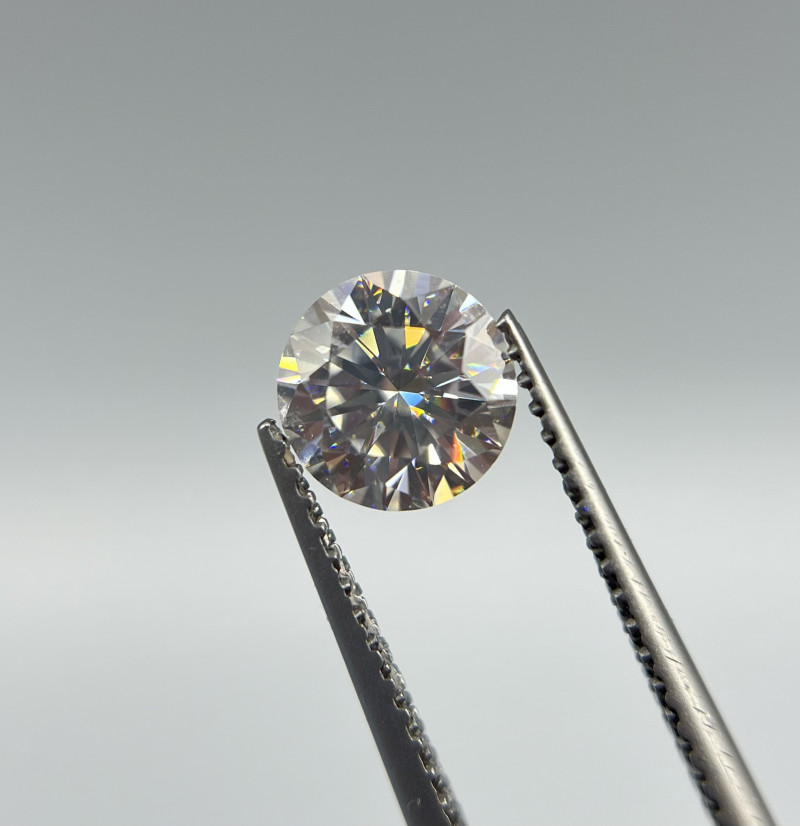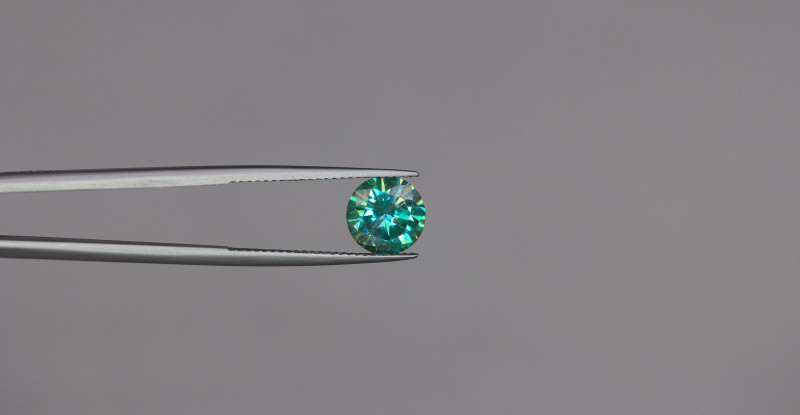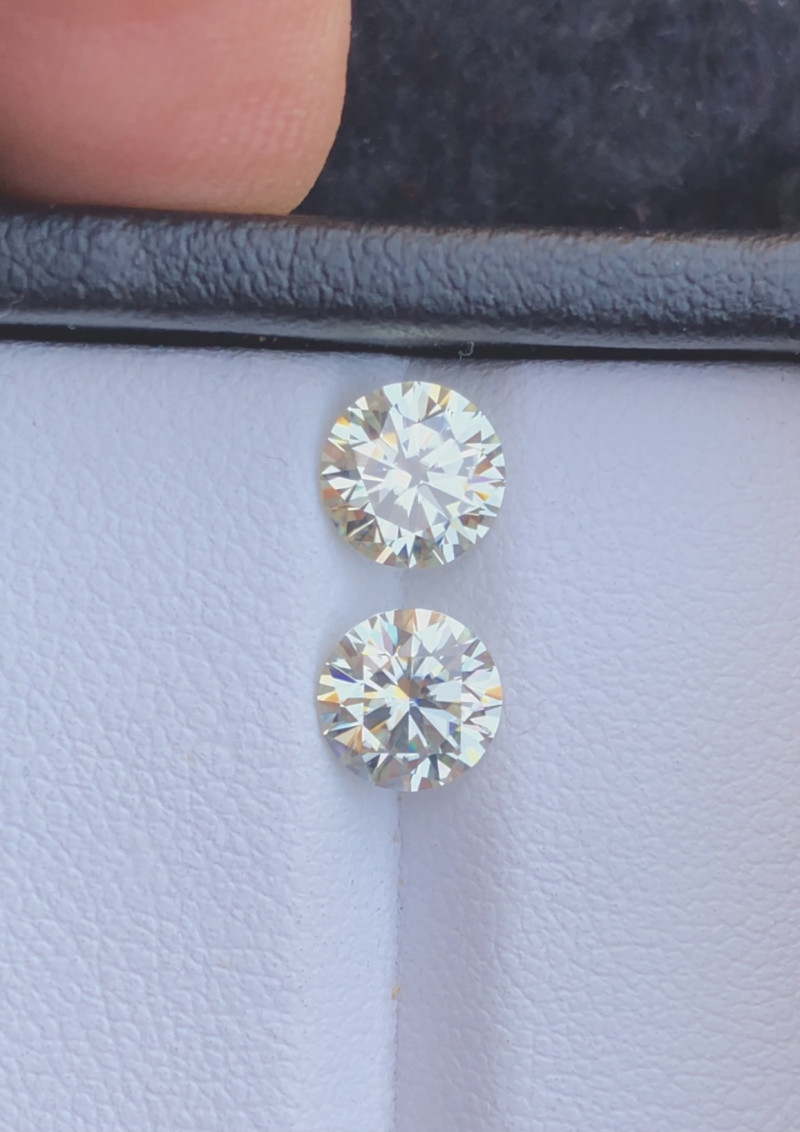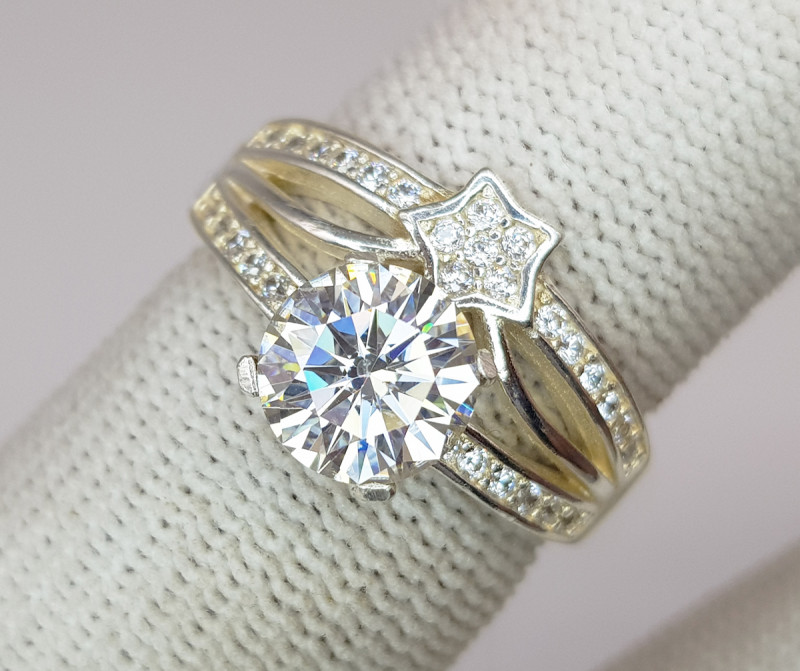Moissanite Gemstone: Properties, Meanings, Prices & Jewelry
 Moissanite (moy-suh-nite) is a transparent, usually colorless gemstone known for its cosmic origins and similarity to diamond. In the jewelry world, many people know the stone as a diamond alternative, particularly moissanite engagement rings.
Moissanite (moy-suh-nite) is a transparent, usually colorless gemstone known for its cosmic origins and similarity to diamond. In the jewelry world, many people know the stone as a diamond alternative, particularly moissanite engagement rings.
Wait, cosmic origins? Is moissanite a meteorite? Not exactly, but the first natural moissanite stones were discovered inside a meteorite! Given the scarcity of space gemstones, is moissanite a rare stone? Yes, natural moissanite is incredibly rare.
You may have heard moissanite is a solely man-made gem. So, is moissanite natural or lab-created? Both! Natural moissanite is so rare, virtually all the moissanite jewelry and gems on the market are lab-created.
Though lab-created, synthetic gemstones share the same chemical and physical properties as the real deal. So not only is moissanite a real gemstone, synthetic or natural, it’s one of the most fascinating ones!
What makes moissanite gemstones so fascinating? We’ll answer that today as we explore moissanite value, traits, origins, and more!

About Moissanite Stone
Moissanite is a semi-precious gemstone that’s usually colorless. Other natural moissanite colors include black, yellow, and green.
As a diamond alternative, moissanite is a more affordable April birthstone and Aries zodiac stone. Though, moissanite’s intergalactic origins mean it benefits any zodiac sign!
Another substitution option is diamond’s place as the traditional 60th wedding anniversary gemstone. Speaking of weddings, is moissanite okay for an engagement ring? Definitely! Moissanite rings are top-tier alternatives. Check out our moissanite vs. diamond guide for a full breakdown!
Moissanite Specifications & Characteristics
What is moissanite made out of? The moissanite chemical formula is SiC, or silicon carbide. Silicon carbide is also manufactured for ceramics and sandpaper. Carborundum is a trade name for moissanite and a synonym for other types of silicon carbide.
Moissanite also has polymorphs with the same composition but different crystal and molecular structures. Polymorphs with molecular structures suitable for gemstone use are limited, though — another reason natural moissanite gemstones are rare.
On the Mohs mineral hardness scale, moissanite hardness is 9.25-9.5. This makes it the second hardest gemstone in the world!
Mohs hardness: 9.25-9.5
Color: Colorless, yellow, green, or black (natural); Virtually any color, including colorless (synthetic)
Crystal structure: Hexagonal
Luster: Adamantine to metallic
Transparency: Transparent
Refractive index: 2.59-2.69
Density: 3.21-3.22
Cleavage: Indistinct on [0001]
Fracture: Conchoidal
Streak: Greenish-gray
Luminescence: Sometimes weak or moderate fluorescence; Orange in LW-UV & rarely SW-UV; Thermoluminescent (heat-induced);
Pleochroism: Weak; Light blue to very light blue or indigo
Now, let’s shift from mineral traits to metaphysical traits.

Moissanite Meaning & History
Moissanite symbolizes inner radiance and untapped potential. Is moissanite a lucky stone? Yep! It’s said to attract prosperity and good fortune, especially in a horseshoe or four-leaf clover moissanite stone necklace.
What is the spiritual meaning of moissanite? Its astral origin evokes universal connection and communication with higher spiritual realms.
History
French chemist Dr. Henri Moissan first discovered moissanite in 1893. Searching for a crystal for industrial use, he ended up in Canyon Diablo, Arizona, USA. Moissan found tiny stones he thought were diamonds in the town’s meteorite crater.
Meanwhile, American chemist Edward Acheson was trying to create synthetic diamonds. During an attempt in 1890, he accidentally made silicon carbide, dubbing it “carborundum.” The process eventually became the “Acheson Process.”
By 1904, Moissan realized his samples were natural silicon carbide. Tiffany gemologist George Kunz named the stone “moissanite” after Moissan in 1905.
The first reported non-meteoric sources of natural moissanite emerged in the 1950s. The crystals were found within rocks in Wyoming, USA, and Yakutia, Russia.
Starting in 1987, Cree Research, Inc. in North Carolina has pioneered mass-manufacturing synthetic moissanite. In 1995, the company C3, Inc. (now known as Charles & Colvard) became the first to make synthetic moissanite gems commercially available.
Thanks to all those pioneers, we can now wear beautiful moissanite stone jewelry! But what are the benefits of wearing moissanite in crystal healing?

Moissanite Healing Properties
All gems can be healing stones, including synthetic ones! Colorless gems like moissanite are said to bring wisdom, clarity, and wholeness. They’re also great chakra stones for the crown chakra, where you connect to higher spiritual power.
Other moissanite colors can bring their own properties. For example, green moissanite shares the same benefits of renewal, luck, and growth as other green stones.
What are the moissanite stone benefits for physical, emotional, and chakra healing?
Physical Healing
Moissanite stones may support heart health and prevent high cholesterol levels. Some use the crystal for greater strength and endurance. For women, moissanite is said to increase fertility and ease stress during pregnancy.
Emotional Healing
Emotionally, crystal healers use moissanite to bring out your full potential, which may be hidden inside you. They also recommend the stone for raising motivation, increasing confidence, and shaking up the mundane.
In your love life, moissanite may bring you greater luck in attracting romance and lower anxiety during first dates. Spiritually, some say the crystal restores your faith — that could be in your religious practice or simply your faith in humanity.
Determining moissanite’s quality as a healing stone is an intuitive decision. But in terms of gemstone value, how can you tell moissanite’s quality?

Moissanite Gemstone Properties
Experts determine moissanite’s quality similarly to diamond: with the 4 Cs — color, clarity, cut, and carat weight.
The “4 Cs” system comes from the Gemological Institute of America (GIA), though they only started offering full color and clarity reports on lab-grown stones in 2020.
What is the best grade of moissanite? The highest grades in each category are:
Color: D (Colorless)
Clarity: FL (Flawless)
Cut: Excellent
The best carat weight isn’t as straightforward, but we’ll explain why in a bit. First, let’s look at moissanite stone colors.
Color
Moissanite color scale grades are below, from highest to lowest value:
D, E, or F (Colorless)
G, H, or I (Almost colorless)
J or K (Tinted, usually in yellow)
D-grade, whether synthetic or natural, is the best color for moissanite in terms of value. Natural stones are rarely colorless, instead showing yellow to brown undertones (J or K grades). Therefore, natural D-color moissanite is incredibly valuable.
Treatments make virtually any moissanite color possible. Fancy color moissanite is popular for custom pieces. These include hues like yellow, gold, blue, purple, pink, gray, and green.
Color also influences a huge factor: sparkle! Dispersion, or “fire,” describes a gem’s rainbow-like sparkle under light. Synthetic moissanite has a “very strong” dispersion (the highest type) of 0.104.
However, darker hues can dampen this sparkle. Only light-colored or colorless moissanites will display the stone’s full fire.
Clarity can also affect dispersion. So, what is the clarity of moissanite?

Clarity
Clarity describes how many inclusions are visible in a gem. The five clarity grade categories are listed below, from most to least valuable:
FL to IF (Flawless, Internally flawless) - Closest to perfect
VVS1 to VVS2 (Very, very slightly included) - Miniscule inclusions not visible under 10x magnification
VS1 to VS2 (Very slightly included) - Tiny inclusions barely seen under 10x magnification
SI1 to SI2 (Slightly included) - Inclusions on sides and center of stone that may be visible to naked eye
I1, I2, or I3 (Included) - Obvious inclusions under 10x magnification
Now, does moissanite get cloudy? No, moissanite will not become cloudy over time (unless it needs cleaning). However, some moissanites will be inherently cloudy from clusters of inclusions.
Besides clouds, possible inclusions or imperfections in moissanite include white needles, feathers (tiny fractures), cavities, chips, and knots (intergrown crystals reaching the stone’s surface).
Cut
Most jewelers employ faceted cuts for moissanite. The stone’s extreme durability means numerous standard, fancy, or master cuts are possible.
Cut quality depends on how well it maximizes light reflection and sparkle. These five grades are more straightforward, from Excellent to Poor.
The most common cuts are brilliant and step cuts, each with various shapes. Moissanite’s inclusions will often inform the cut. Step cuts show better clarity, while brilliant cuts are, well, more brilliant! Mixed cuts like cushion or princess cuts provide the best of both worlds.
Carat Weight
Carat weight grading is tricky for a few reasons. For one, different cuts can make the stone appear smaller. Color-wise, moissanites larger than 1-carat can look more green or yellow. But, tiny moissanites won’t display brilliance well, though they look clearer.
To keep all the factors in balance, we recommend getting a 1-carat moissanite gemstone. Be aware that some sellers may go by size (in mm) rather than carat weight.
Treatments
Moissanites aren’t usually treated. Jewelers occasionally enhance or change the color via coating or high-pressure, high-temperature (HPHT) treatments.
HPHT treatments remove obvious yellow to brown undertones and make moissanite more clear. Jewelers can also fix yellow undertones, or change the color entirely, with Chemical Vapor Deposition (CVD). CVD involves putting a bonding agent on moissanite’s bottom half, then layering color over that.
Another coating treatment is ion induction, which turns clear moissanite into pink, purple, red, or orange moissanite. However, the color can fade or come off completely from regular jewelry maintenance.
 Image credit: By Andrew Silver - BYU Mineral Specimens 799 USGS Photographic Library, Public Domain
Image credit: By Andrew Silver - BYU Mineral Specimens 799 USGS Photographic Library, Public Domain
Moissanite Formation & Sources
We know natural moissanite can be found in some iron meteorites, as well as inclusions in diamonds and rocks like kimberlite.
However, scientists aren’t sure how moissanite forms. Because moissanite is often found beside diamonds, some theorize that it forms in Earth’s upper mantle.
Luckily, we know how synthetic moissanite forms! The basic process starts with heating carbon and silica to roughly 1400-2000℃. From there, silicon atoms do the work of rearranging themselves into crystals.
Mining Locations
Where is natural moissanite found? Arizona, USA, is the primary source, but Israel boasts the largest natural moissanite crystal.
We’ll list the other locales below:
Czechia
Israel
Siberia
Turkey
USA (Kansas & Wyoming)
Yakutia (or Sakha)
The most famous producer of synthetic moissanite is Charles & Colvard in America.
Since it’s usually synthetic, is moissanite worth anything?

Moissanite Price & Value
Moissanites are pretty affordable, especially compared to diamonds. Why are moissanites so cheap? The stones aren’t well-known, so demand is low.
A 1-carat, almost colorless, round-cut moissanite stone for sale will cost around $450-$600.
Looking at rings, a 2-carat moissanite ring will be around $1,200, while a 3-carat ring will be closer to $3,000. Moissanite earrings are lower at around $70-$250 at wholesale.
Colored (treated) moissanite loose stones’ wholesale price range is even more affordable, ranging from $10-$80 for stones around 1-carat. Colored moissanite rings, in 0.5- to 1-carat sizes, are under $250 and usually $35-$90 at wholesale.
Moissanite Care and Maintenance
Proper gemstone care is essential, even for tough stones like moissanite. Its color and clarity doesn’t fade, so any dullness can be fixed with cleaning.
Here are the steps for cleaning moissanite:
In a bowl, mix warm water with mild, liquid detergent.
Dip a soft brush (e.g. toothbrush) into the mixture.
Use the brush to lightly scrub the moissanite.
Thoroughly rinse the stone with lukewarm water.
Dry it with a hairdryer, container of rice, or microfiber cloth.
Can you wear moissanite in the shower? Yes, but that may mean cleaning it more frequently. Soaps in shower products create a filmy build-up over time.
Does chlorine ruin moissanite? Taking a swim won’t affect moissanite unless it takes a hard blow against the pool wall. However, chlorine can affect metal jewelry settings.
Moissanite can scratch other gems, so store them separately.

Seeking a Celestial, Sparkling Stone?
Even though Moissan sought silicon carbide for industrial use, he ended up blessing the gemstone community with a gorgeous gem. An affordable, sparkling crystal that brings out your inner radiance? That’s a stellar steal!
Was this article helpful?
1 person found this article helpfulRoss Sedawie
- Written - 17th Apr 2022
- Edited - 1st Aug 2023
















